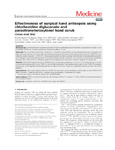Mostrar o rexistro simple do ítem
Effectiveness of Surgical Hand Antisepsis Using Chlorhexidine Digluconate and Parachlorometaxylenol Hand Scrub
| dc.contributor.author | López-López, Daniel | |
| dc.contributor.author | Becerro-de-Bengoa-Vallejo, Ricardo | |
| dc.contributor.author | Sevillano Fernández, David | |
| dc.contributor.author | Alou, Luis | |
| dc.contributor.author | Martín Aragón, Laura | |
| dc.contributor.author | Losa Iglesias, Marta Elena | |
| dc.contributor.author | Collado Yurrita, Luis Rodolfo | |
| dc.date.accessioned | 2022-03-09T11:24:44Z | |
| dc.date.available | 2022-03-09T11:24:44Z | |
| dc.date.issued | 2018-10 | |
| dc.identifier.citation | Vallejo, Ricardo Becerro de Bengoa PhD, DPM, DHLa; Fernandez, David Sevillano PhDa; Cervera, Luis Alou PhDb; Aragón, Laura Martín PhDa; Iglesias, Marta Elena Losa PhDc,∗; Yurrita, Luis Rodolfo Collado MD, PhDa; Lopez, Daniel Lopezd Effectiveness of surgical hand antisepsis using chlorhexidine digluconate and parachlorometaxylenol hand scrub, Medicine: October 2018 - Volume 97 - Issue 42 - p e12831 doi: 10.1097/MD.0000000000012831 | es_ES |
| dc.identifier.uri | http://hdl.handle.net/2183/29928 | |
| dc.description.abstract | [Abstract] Background: Chlorhexidine and parachlorometaxylenol (PCMX) are antiseptics recommended for surgical hand antisepsis. To our knowledge, PCMX has not been evaluated for bactericidal efficacy “in vivo. Methods: We conducted a randomized, double-blind, controlled crossover trial to compare the bacterial loads on fingertips and fingernails under laboratory conditions after use of antiseptic test products, including chlorhexidine digluconate 4%, PCMX 3%, and a reference solution of propan-1-ol 60% (P-1). We assessed bacterial load after a prewash with soft soap, immediately after application of an antiseptic, and 3 hours after application and wearing of sterile, powder-free gloves. Our procedures followed those specified by European Norm (EN) 12791 for evaluating surgical hand antiseptics and using cotton swab for fingertips and fingernails. Results: Chlorhexidine digluconate 4% and PCMX 3% did not decrease bacterial load on the hands. The bactericidal performances of chlorhexidine digluconate 4% and PCMX 3% did not differ significantly. Chlorhexidine digluconate 4% and PCMX 3% increased bacterial load on the fingertips after participants had worn gloves for 3 hours. Fingernails had greater bacterial loads than skin on the fingertips. Conclusions: Chlorhexidine digluconate 4% and PCMX 3% had similar bactericidal efficacy, but they failed to meet the EN 12791 efficacy standard. Fingernails should be a particular focus of antisepsis in preparation for surgery. The trial was registered at ClinicalTrials.gov (ID: NCT02500758). | es_ES |
| dc.language.iso | eng | es_ES |
| dc.publisher | Wolters Kluwer | es_ES |
| dc.relation.uri | http://dx.doi.org/10.1097/MD.0000000000012831 | es_ES |
| dc.rights | Atribución-NoComercial 4.0 Internacional | es_ES |
| dc.rights.uri | http://creativecommons.org/licenses/by-nc/4.0/ | * |
| dc.subject | Antisepsis | es_ES |
| dc.subject | Antisepsia | es_ES |
| dc.subject | Randomized controlled trial | es_ES |
| dc.subject | Ensayo controlado aleatorizado | es_ES |
| dc.subject | Surgical site infection | es_ES |
| dc.subject | Infección del área quirúrgica | es_ES |
| dc.title | Effectiveness of Surgical Hand Antisepsis Using Chlorhexidine Digluconate and Parachlorometaxylenol Hand Scrub | es_ES |
| dc.type | journal article | es_ES |
| dc.rights.accessRights | open access | es_ES |
| UDC.journalTitle | Medicine | es_ES |
| UDC.volume | 97 | es_ES |
| UDC.issue | 42 | es_ES |
| UDC.startPage | 12831 | es_ES |
| UDC.coleccion | Investigación | es_ES |
| UDC.departamento | Ciencias da Saúde | es_ES |
| UDC.grupoInv | Grupo de Investigación Saúde e Podoloxía (GISAP) | es_ES |
Ficheiros no ítem
Este ítem aparece na(s) seguinte(s) colección(s)
-
Investigación (FEP) [514]






